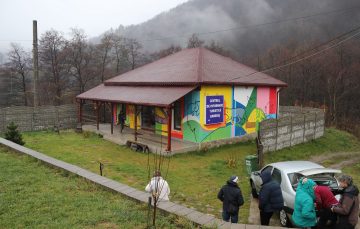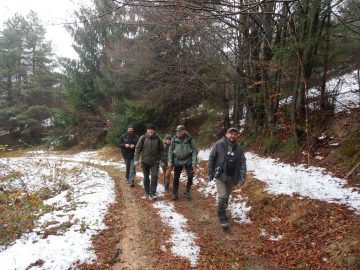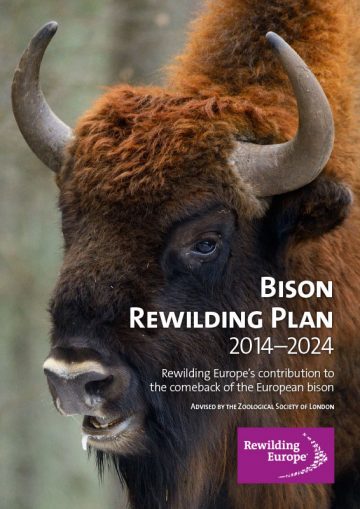Teams exchange insight and experience, while Polish history of bison reintroduction bodes well for the Romanian rewilding programme.

After members of the Polish LIFE Bison project reached out to their Romanian counterparts, the end of November saw a meeting of the two teams take place in the Southern Carpathians. I have had the pleasure of being involved with the Polish project, which focuses on the diversification and development of the European bison population of Western Pomerania in northwestern Poland, since 2015. In early November this year, the Polish LIFE bison project became a member of the European Rewilding Network (ERN).
After a long day’s journey from northern Poland, members of the Polish team arrived in the Southern Carpathians rewilding area, in the Tarcu Mountains, on November 21. The following day we visted the bison visitor centre in Armeniș, together with the town mayor and several guests.

The centre, which is equipped with many interesting and interactive installations showing European bison in the ecosystem, performs an educational and informational role for the bison reintroduction project. Such places are very important when we reintroduce a new species into wild nature, especially one that impacts the local environment as much as the bison.
The centre attached to our Polish project acts as a bison breeding and demonstration farm. Here tourists can experience bison up close, and learn more about bison ecology and behaviour, which often improves their attitude towards these magnificent animals. I firmly believe that the bison centre in Armeniș will continue to help local people accept the reintroduced bison, and this will make their protection far easier.
After a visit to the centre it was time to see the rewilding area first hand. First we journeyed deep into the mountains to inspect the enclosure where groups of reintroduced bison become acclimatised to the local environment before their release. Then we set off in search of the bison themselves.
Being November, the weather was cold, with a temperature close to zero and the ground covered in a thin blanket of snow. Thanks to this we could see the tracks of bison and many other animals. We even managed to find the tracks of lynx, which goes to show just how suitable this area is for wild animals to thrive. A land of mountains, beech forest and former pastureland, there are virtually no signs of human life here.

Such habitat may be the ideal place for the development of a bison population, but is not conducive to actually searching for bison. During our 90-minute trip we didn’t see a single animal, but still encountered much evidence of their existence in the form of tracks and scat.
Without proper telemetry it is difficult to locate animals in the field, especially in the mountains. We know this from our own experience. We also have bison distributed over a large area in thick forest, where it would be difficult to find them without equipment.
When we started using telemetry on a larger scale (currently about 20% of the West Pomeranian bison population has collars) we were able to get to know the movement of animals well enough to protect them effectively. In the future, with the Southern Carpathian bison population increasing, I think it would be worth using telemetry for monitoring and protecting the animals. It definitely makes work easier!
At the end of our walk we reached a small stone house, which will serve as a base for volunteers or interns who want to help in bison conservation. The involvement of volunteers is mutually beneficial: they help during the most intense field work, when every pair of hands counts, while at the same time gaining valuable professional and life experience. After a rest and second breakfast, we returned to our accommodation, holding a long discussion late into the night on the subject of bison and the experience we have gained during our own LIFE project.
A tale of two countries
Poland and Romania may be distant from each other, but a similar history over several decades means we share very similar problems in terms of animal conservation. One of these problems is burdensome bureaucracy and unclear regulations that complicate and delay conservation efforts.
Another chalenge arising during the reintroduction of bison in Romania is fostering acceptance of their presence by the community. We learned that even if the bison are in unused areas, local people have sometimes been unhappy.

In our project we have had similar issues, with the mere sight of bison once causing antagonism. We have managed to mitigate these conflicts by operating a bison emergency service. This involves scaring bison away from farmland and holding personal meetings and conversations with farmers. It is very important to help people in their problems with bison, and not to ignore them.
The Romanian project also helps local people to protect their properties and land against bison damage. This is achieved by the installation of electric fences in areas most likely to be visited by bison. We like this idea very much and I think that in the future this will result in increased acceptance of the species.
In conclusion, time is the most important factor in the development of bison populations, and the solution of any associated problems. The Romanian project is currently at the stage we were at about a decade ago. Many things have changed in Poland since then, with bison numbers increasing from 22 in 2005 to around 200 now.
The main influence on our bison numbers has been introduction of several new individuals into herds, and an increase in fertility rate due to entry of young females into their reproductive period. I think that the bison population in the Southern Carpathians rewilding area will develop as dynamically as ours. We just have to wait patiently for it, because, as we have now witnessed first hand, local conditions are very favourable!
- Learn more about Rewilding Europe’s work in the Southern Carpathians.
- Read about the Polish bison project.
- More information about the LIFE Bison project.
- Track reintroduced bison in the Southern Carpathians through the European Safari Company.
